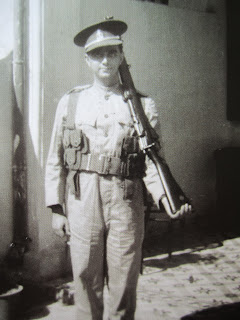Private David Marshall, B Company, 1st Battalion SSVF
David, centre of picture with pipe, at Nisi-Asibetsu POW Camp, Japan 1945
David Marshall, a lawyer, soldier, Chief Minister, politician, diplomat in Singapore
At the time of the Munich Crisis 1938, when Germany invaded Czechoslovakia, David Marshall decided to join the Straits Settlement Volunteer Force (SSVF) as a private soldier at the age of 30 – due to an intense hatred of all forms of dictatorial government.
He recalled then “This is going to be the next great War. Germany on one side and Japan on the other. Japan is going to come here. This is my country (geographically). And I went to the Volunteers and said I wanted to join”.
David was with Allen and Gledhill – founded by Rowland Allen and John Joseph Gledhill in 1901. The law firm was the largest in Singapore, managed by three European partners. One of the partners, William Munro was also a SSVF Volunteer. David joined the firm in 1940, was the first Asian assistant and was paid $750 per month. Another Asian assistant, Wee Chong Jin, joined later in the same year. He was destined to be Chief Justice of Singapore.
The SSVF was set up along racial lines i.e. The 1st and 2nd SSVF Battalions, Singapore had 6 companies: Company A( British), B ( Europeans), Company C (Scottish), Company D(Eurasians), Company E (Chinese), Company F(Malays). When David joined, he was not European and there was no Jewish company. He declared himself a Jew and “an Asian” and was offended when they registered him as an Asian and shunted him to the Eurasian Company D. He refused and was reassigned to B Company where he met William (Bill) Goode, who was to become the last British governor of Singapore.
Bill recalled that David was not a very smart soldier – he dropped the Lewis gun in a pig-pond in the back of Changi and that they all have to clean it afterwards.
The volunteers were issued and drilled with the Lee Enfield .303 rifles. There were group training with light machine guns such as the Lewis gun, the Bren gun and the Thomson sub-machine gun. Training was conducted on Tuesday evenings and Saturday afternoons – hence the volunteers were also called “Saturday Night Soldiers” by the regulars.
Weekly trainings were supplemented with a few weekend camps and once a year, a fortnight in-camp training. In mid 1940, the volunteers were called up for a two month in-camp training at Telok Paku, Changi ( 26 km from town)in July- August 1940 and April- May 1942. They were accommodated in huts with shower facilities and each day begans with a dawn parade for physical training, followed by showers, shave dressing, breakfast and inspection. In the evenings, there were lectures and indoor gun-drills. After dinner, the men were free to rest, play bridge or other card games.
On weekends, the married men can sleep out but had to return to camp before midnight by Sunday. Besides, employees such as mercantile assistants were allowed to return to work at 2pm and return to camp for parade by 5.15 pm from Monday to Friday in view of the long absence from work during these in-camp training.
The 1942 training were intensified conducted by regular British Army Instructors to include mock battles with blank ammunition and thunder flashes staged in the rubber estates of Sembawang and Tampines. There were unarmed combat and weekly route marches – a distance of 25 km to be completed within 3 hours. Each platoon had one Lewis light machine gun and was also issued with a Boys Rifle that can fire a 0.55 inch bullet against armour of light tanks. Meantime, new volunteers no longer had their kit measure out and tailored by Chinese contractors – standard kits were issued to all volunteers. Each week there was pay parade and European volunteers were paid $1.04 per day whilst Asians were paid 52 cents—paid along racial lines.
On 1 Dec 1941, a state of emergency was declared in Malaya and Singapore. Governor Sir Shenton Thomas issued a mobilization order to call upon the SSVF for active service. Volunteers reported at the SSVF HQ at Beach Road for active service where they complete all administrative procedures with the issuance of army books, identity discs, rifles, bayonets and ammunition.
They were then transported to the Geylang English School once they have been processed and kitted up, plus the collection of company’s general stores. The school has been requisitioned as the HQ for 1st Battalion, SSVF Singapore which has A, B, C & D Companies. 1st SSVF has been assigned to defend the beaches from Bedok to just pass the Singapore Swimming Club at Tanjong Rhu from Dec 1941 to Feb 1942. The volunteers spent the next two months digging trenches and putting up many barb wire strong-points. The defence from Bedok to Changi was assigned to the Manchester Regiment.
11 Feb 1942, B Company was moved to Peirce Road to reinforce an Australian Battalion. David was made the company runner. The company occupied the tennis courts securing Holland Road from elevated ground for 24 hrs. Next, they secure Ridout Road for four days supporting the frontline.
14 Feb 1942, the Japanese had broken through the frontlines right down to the Kong Guan Biscuits Factory on Alexandra Road and the volunteers were prepared for a counterattack at dawn the next day. However, that evening of the 14th, David was summoned to Company HQ to be told that the British were surrendering.
B Company spent the next 2 nights camped at Peirce Road before being told to march to Changi. The SSVF forces gathered at Goodwood Park Hotel on Scotts Road. Their helmets have been confiscated to be shipped back to Japan for recycling.
Extracted from “Marshall of Singapore – A biography” by Kevin Tan


No comments:
Post a Comment